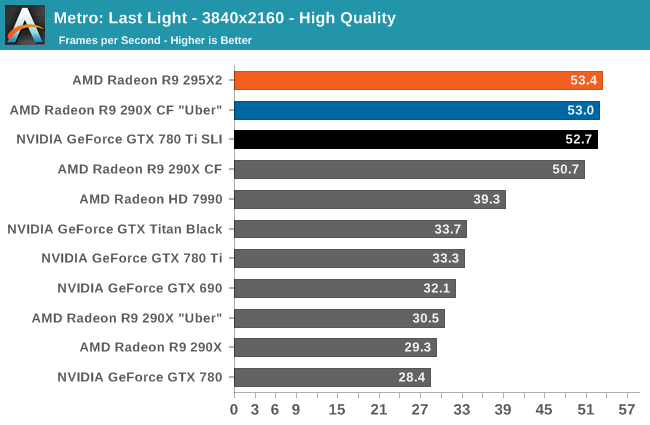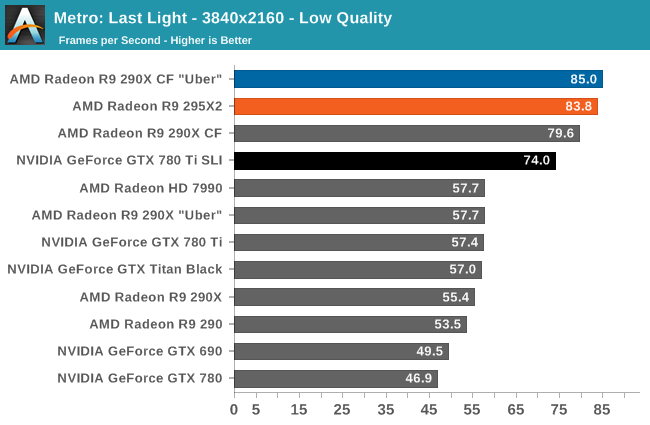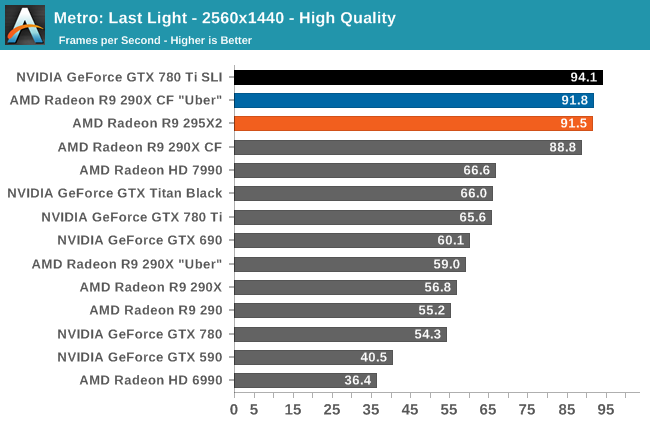The AMD Radeon R9 295X2 Review
by Ryan Smith on April 8, 2014 8:00 AM EST- Posted in
- GPUs
- AMD
- Radeon
- Radeon 200
Metro: Last Light
As always, kicking off our look at performance is 4A Games’ latest entry in their Metro series of subterranean shooters, Metro: Last Light. The original Metro: 2033 was a graphically punishing game for its time and Metro: Last Light is in its own right too. On the other hand it scales well with resolution and quality settings, so it’s still playable on lower end hardware.



Our first gaming benchmark pretty much sets the tone for what we’ll be seeing in this review. In building the 295X2 AMD set out to build a single card that could match the performance of the 290X “Uber” In Crossfire, and that is exactly what we see happening here. The 295X2 and 290XU CF swap places due to run-to-run variation, but ultimately both tie together, whether it’s above the GTX 780 Ti SLI or below it.
As we’ve already seen with the 290X, thanks in part to AMD’s ROP advantage, AMD’s strong suit is in very high resolutions. This leads to the 295X2 edging out the competition at 2160p, while being edged out itself at 1440p. None the less between AMD and NVIDIA setups this is a very close fight thus far, and will be throughout. As for Metro, even at the punishing resolution of 2160, the 295X2 is fast enough to keep this game going at above 50fps.










131 Comments
View All Comments
eotheod - Tuesday, April 8, 2014 - link
Same performance as crossfire 290X? Might be time to do a Mini-ITX build. Half the price of Titan Z also makes it a winner.Torrijos - Tuesday, April 8, 2014 - link
A lot of compute benchmark see no improvement from a single 290X...What is happening?
Ryan Smith - Tuesday, April 8, 2014 - link
Most of these compute benchmarks do not scale with multiple GPUs. We include them for completeness, if only to not so subtly point out that not everything scales well.CiccioB - Tuesday, April 8, 2014 - link
Why not adding more real life computing tests like iRay that runs both for CUDA and OpenCL?Syntethic tests are really meaningless as they depends more on the particular istructions used to do... ermm.. nothing?
fourzeronine - Tuesday, April 8, 2014 - link
iRay runs on CUDA only. LuxRender should be used for GPU raytrace benchmarking. http://www.luxrender.net/wiki/LuxMarkAlthough the best renderers that support OpenCL are hybrid systems that only solve some of the problems on GPU and a card like this would never be fully utilized.
The best OpenCL bench mark to have would be an agisoft photoscan dense point cloud generation.
Musaab - Wednesday, April 9, 2014 - link
I have one question why didn't you use 2 R9 290X with water cool or 2 GTX 780Ti with water cool. I hate this marketing Mumbo Jumbo. if I want to pay this money I will chose two cards from above with water cool and with some OC work they will feed this card the dust and for the same money I can buy 2 R9 290 or 2 GTX 780.Musaab - Wednesday, April 9, 2014 - link
Sorry I mean three R9290 or three GTX 780spartaman64 - Sunday, June 1, 2014 - link
i doubt you can afford 3 of them and water cool them and 3 of them would have a very high tdp also many people would run into space restraints and the r9 295x2 out performs 2 780 ti in slikrutou - Tuesday, April 22, 2014 - link
Because water blocks and radiators don't grow on trees. Reviewers only test what they're given, all of which are stock.patrickjp93 - Friday, May 2, 2014 - link
They pretty much do grow on trees. You can get even a moderately good liquid cooling loop for 80 bucks.